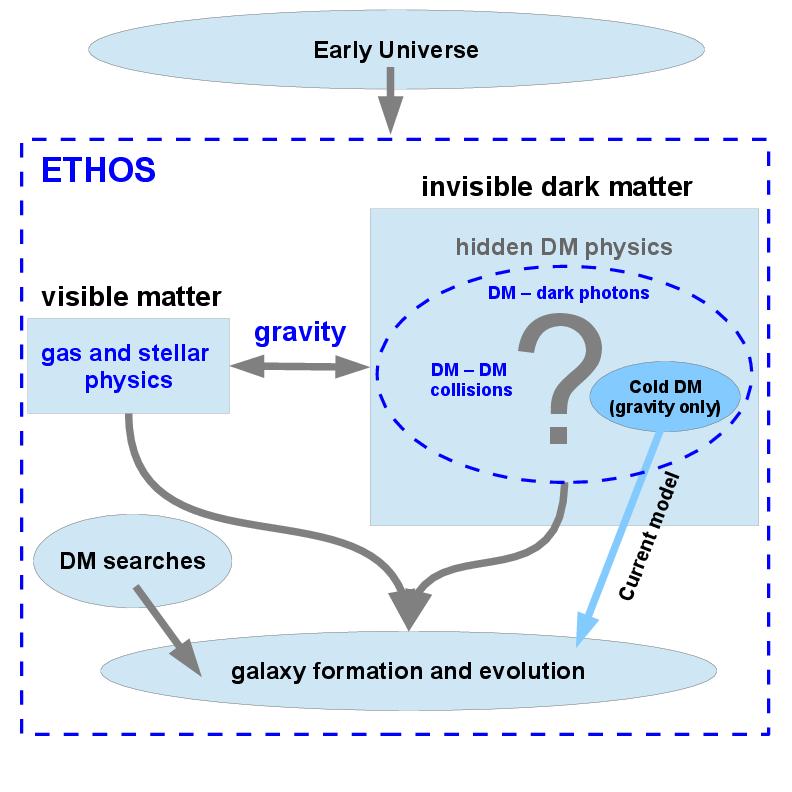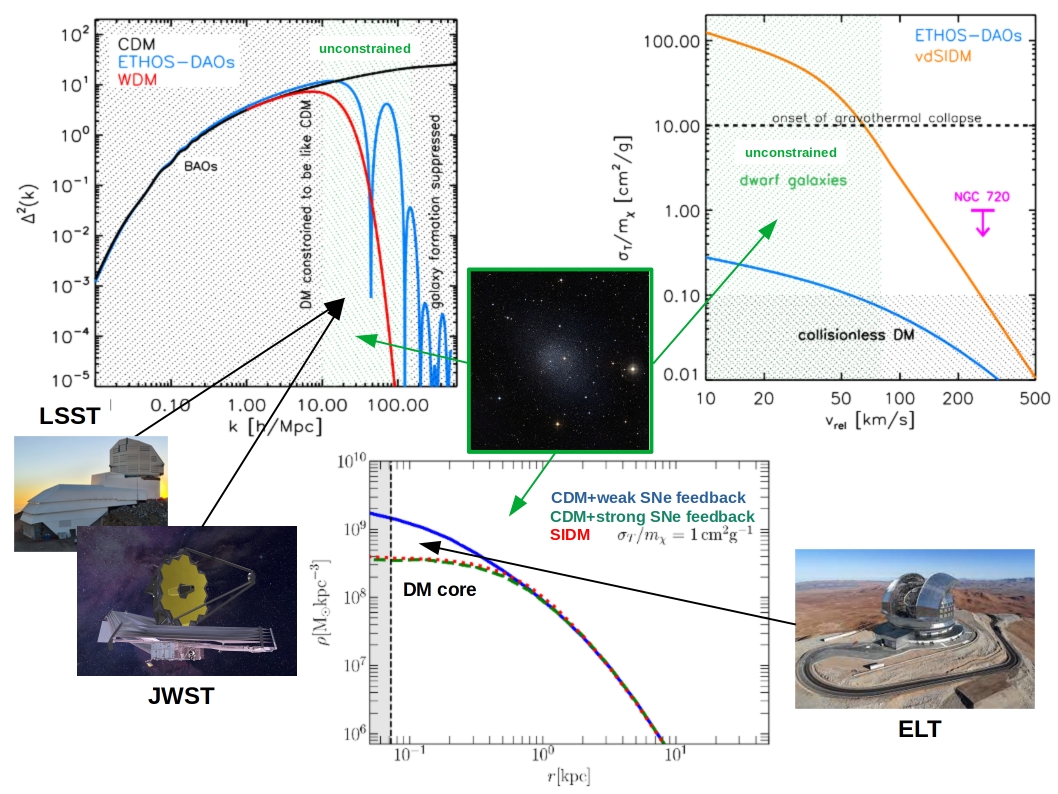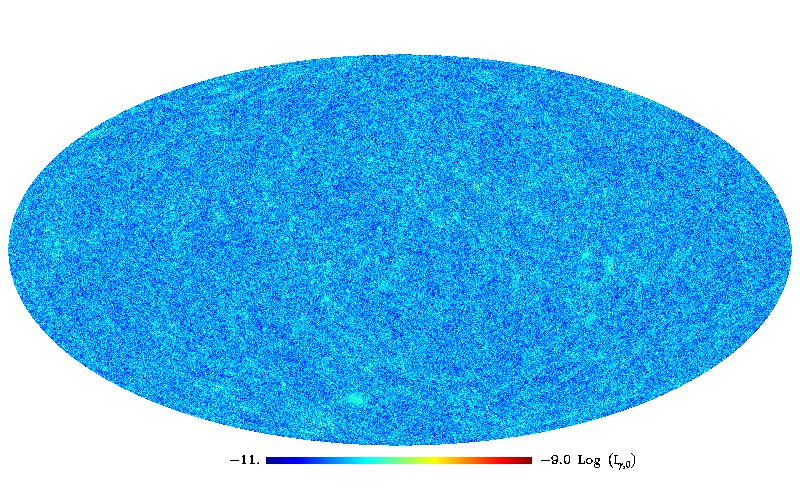Research Highlights
Dwarf galaxies in the coming decade and the ETHOS framework.
The current paradigm of structure formation, the Cold Dark Matter (CDM) model, assumes that dark matter is collisionless and cold (with very low thermal motions). In the CDM model, gravity is the only dark matter interaction that is relevant in the formation and evolution of galaxies. Observations of the abundance and properties of dwarf galaxies might be challenging these hypothesis. The current situation offers an opportunity to approach the DM problem from a broader perspective. In collaboration with an international team working at the intersection between astrophysics, cosmology and particle physics, we have been developing an effective theoretical framework (ETHOS, see figure below) that enables cosmological structure formation to be computed in a range of models with diverse DM physics (Cyr-Racine, Sigurdson, Zavala et al. 2016). This framework maps the particle physics parameters of DM theories into the physical effective parameters that shape the linear matter power spectrum and the DM self- interaction cross section. These are the input to structure formation simulations, which follow the growth of DM structures across time. We have performed the first simulations of this kind using ETHOS (Vogelsberger, Zavala et al. 2016), focusing in a Milky-Way- size halo, and demonstrate its potential as a generic theory of structure formation.

An Effective THeory Of Structure formation (ETHOS) with new DM physics.

What are the main physical mechanisms shaping dwarf galaxies? Upper left: linear DM power spectrum (DM clustering as a function of scale). In the black hashed area on the left-hand side, DM is constrained to behave as CDM, while on the right-hand side, galaxy formation is strongly suppressed due to the impact of reionisation. At the scale of dwarf galaxies, the DM clustering remains unconstrained. Models such as Warm DM and interacting DM (ETHOS-DAOs), have a distinct behaviour at dwarf-scales (a cutoff), which impacts the abundance and structure of the galaxies within. Mid-bottom: The internal kinematics of dwarf galaxies (such as Fornax shown in the figure) remains a challenge to the Cold Dark Matter model with many dwarfs possibly having flat density DM cores. Such cores can be created via either energy injection from strong SNe feedback or via strong DM self-interactions (SIDM), which remain poorly constrained ad the scale of dwarfs (upper right panel). Upcoming observations in this decade (e.g. LSST, JWST, ELT) are expected to either close the window for new DM interactions affecting the physics of galaxies, or uncover new clues about its particle nature. Figs. adapted from Zavala et al. 2019.
Going beyond the CDM model
I have been interested in testing alternative models where the properties of dark matter as a particle play a major role in the physics of galaxies. In particular, I have studied Warm Dark Matter (WDM), Self-interacting Dark Matter (SIDM) and models with dark matter interactions with "dark radiation" in the early Universe. These extensions to the CDM model share its successes in reproducing the large-scale structure of the Universe, and have the potential of solving the small-scale problems.

Projected dark matter density at z=0 for simulations of the local Universe in a WDM model (left) and of a Milky-Way-size dark matter halo in a SIDM model (right).
Associated articles: ApJ, 2009, 700, 1779 MNRAS, 2012, 423, 3740 MNRAS, 2013, 430, 1722 MNRAS Letters, 2013, 431, L20 MNRAS, 2014, 444, 3684 PRD, 2014, 90, 043524
Dark matter annihilation. Although there is substantial evidence for the existence of dark matter from its gravitational effects in the visible ordinary matter, a definitive proof requires a non-gravitational signature. I have been interested in the prospect of such detection by looking for the byproducts of the hypothetical annihilation of dark matter.


Full-sky maps of the gamma-ray radiation background expected from the annihilation of dark matter in extragalactic structures (left) and in the smooth galactic halo (right).
Associated news and articles: MPA Research highlights October 2009 MNRAS, 2010, 405, 593 PRD, 2011, 83, 123513 MNRAS, 2013, 429, 1529
P2SAD. Recently, together with Niayesh Afshordi, I have developed a model to compute the Particle Phase Space Average Density (P2SAD) in galactic haloes, a novel measure of the clustering of dark matter introduced in Zavala & Afshordi 2013a. Our model for P2SAD, calibrated with state-of-the-art N-body simulations, can be used to estimate signals sensitive to the nanostructure of dark matter distributions (e.g. dark matter annihilation). A description of the model is given in Zavala & Afshordi 2013b, while an IDL code that computes P2SAD with our model is publicly available at this link. In Zavala & Afshordi 2016 we showed that P2SAD within subhaloes is remarkably universal across seven orders of magnitude, over a 2D phase space, covering over three orders of magnitude in distance/velocity. Invoking the universality of P2SAD, we can accurately predict the non-linear power spectrum of dark matter at small scales all the way down to the decoupling mass limit of CDM particles.
In Zavala 2014, I proposed a novel idea to explain the cosmic high-energy neutrinos recently discovered by the IceCube collaboration based on dark matter annihilation. I show that this is viable possibility, wrongly disregarded in the past, and compute the corresponding predicted signal using P2SAD.
Marie Curie Research project: From early 2014 to early 2016, I kept a blog related to my Marie Curie research project. You can find the blog in this address .